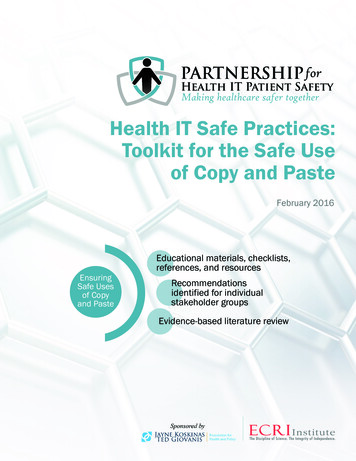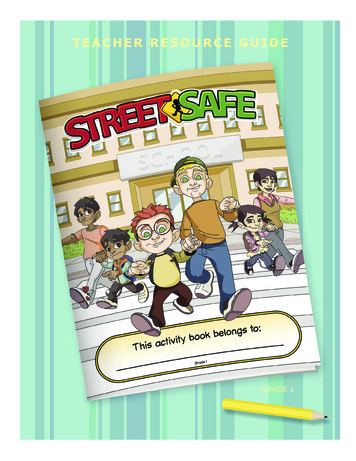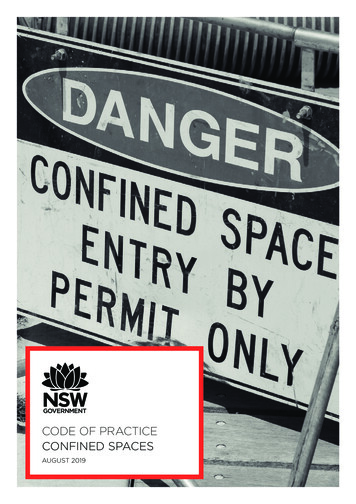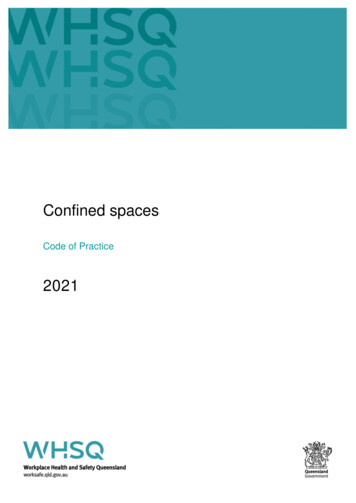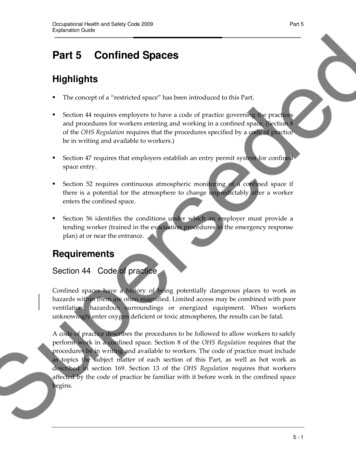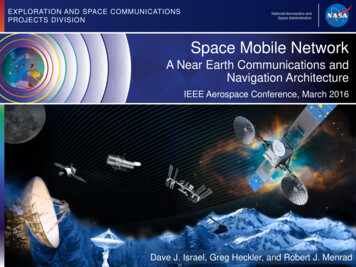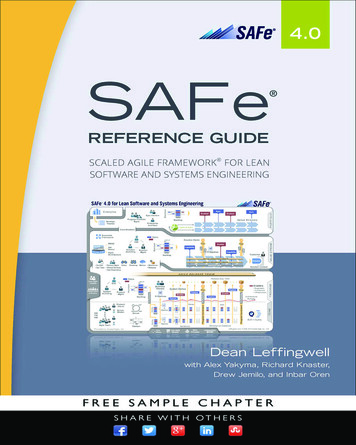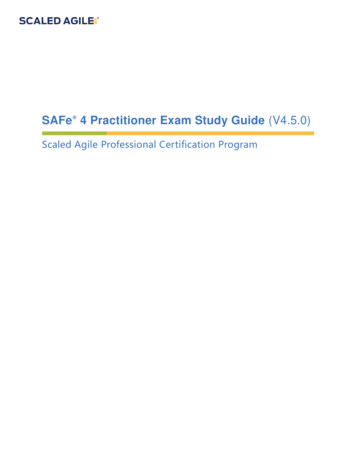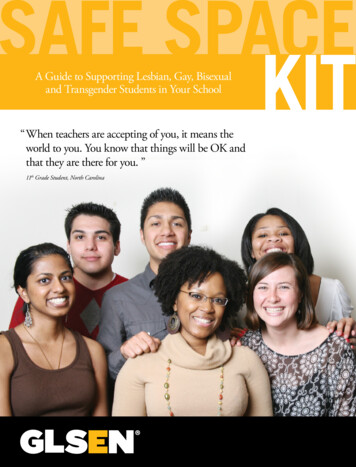
Transcription
SAFE SPACEKITA Guide to Supporting Lesbian, Gay, Bisexualand Transgender Students in Your School“ When teachers are accepting of you, it means theworld to you. You know that things will be OK andthat they are there for you. ”11th Grade Student, North Carolina
The Safe Space Kit:Guide to Being an Ally to LGBT StudentsNational Headquarters110 William St., 30th FloorNew York, NY 10038Ph: 212-727-0135 Fax: 212-727-0254DC Policy Office1001 Connecticut Ave. NW, Suite 206Washington, DC 20036Ph: 202-621-5819 Fax: 202-347-7781info@glsen.org www.glsen.org 2016 GLSENISBN 978-1-934092-07-1GLSEN is the leading national education organization focused on ensuring safe and affirming schools for all students.GLSEN envisions a world in which every child learns to respect and accept all people, regardless of sexual orientation,gender identity or gender expression.p h o t o g r a p h y:D e s i gn :Conrad VenturGlenn GonthaElectronic versions of this guide and other resource materials for educators are available online atwww.glsen.org/educator.GLSEN’s Safe Space Campaign was launched and sustained through leadership support from theWells Fargo Foundation and thousands of individuals, foundations, organizations and corporations whosedonations are making schools safe and respectful for all students.
Questions About the Safe Space Kit4Know the Issues10Support20Educate26Advocate34Additional Resources35GLSEN Resources37Other Resources39Referral List for LGBT Youth40Glossary of LGBT-Related TermsContents2
A Safe Space is a welcoming, supportive and safe environment forlesbian, gay, bisexual and transgender (LGBT) students. From GLSEN’sNational School Climate Survey, a biennial survey of LGBT secondaryschool students, we know that school is not always a safe place for LGBTstudents. Most LGBT students frequently hear anti-LGBT language andexperience harassment related to their sexual orientation and genderexpression, and the majority of LGBT students feel unsafe at school andare likely to skip class or even full days of school to avoid the anti-LGBTname-calling, bullying and harassment they face on a daily basis. Buteducators can make a big difference! For many students, simply knowingthat allies exist can be a source of support. Research shows that LGBTstudents with many supportive educators feel safer at school, skip fewerclasses, and earn higher grades than students without supportive educators.By using this kit, we hope you will become one of these supportive educators.What does the Safe Space symbol mean?You might recognize some of the components ofthe Safe Space symbol, which is a combination ofthe LGBT pride flag and the gay pink triangle andlesbian black triangle. The history of the pink andblack triangles began in Nazi Germany during WorldWar II. Each prisoner in the concentration campswore some symbol, often a colored inverted triangleto designate their reason for incarceration. Thepink triangle was for homosexual men. The blacktriangles were used to designate prisoners with “antisocial” behavior, including lesbians. In the 1970s,gay liberation groups resurrected the pink triangleas a symbol for the gay rights movement. Similarly, the black triangle wasreclaimed by lesbians and feminists.The LGBT pride flag, or the rainbow flag, first appeared in 1978, whenit was flown during the San Francisco Gay and Lesbian Freedom DayParade. The San Francisco artist Gilbert Baker designed the rainbow flagin response to a need for a symbol that could be used year after year. Thedifferent colors of the flag symbolize different components of the community: red for life, orange for healing, yellow for sun, green for nature, bluefor art, and purple for spirit. A black stripe added at the bottom symbolizesa hope for victory over AIDS.Questions About the Safe Space KitWhat is a Safe Space?
We’ve combined both of these potent symbols — the triangles and the pride flag — for theSafe Space symbol displayed on the stickersand posters. The emblem reminds us of the joyof the diverse, accepting community we hope tobuild through programs like Safe Space, as wellas the struggle against oppression we face aswe try to make that vision a reality.What is the Safe Space Kit?The Safe Space Kit is designed to help educators create a safe space for LGBT students.One of the most effective ways for an educatorto create a safe space is to be a supportive allyto LGBT students. The hard copy of the SafeSpace Kit includes the Guide to Being an Ally,ten Safe Space stickers and two Safe Spaceposters. The downloaded PDF of the SafeSpace Kit includes the Guide to Being an Ally,a printable poster and printable stickers. TheGuide to Being an Ally provides educators withpractical ways that they can be allies to LGBTstudents and create a safer school environmentfor all students. By displaying the posters andstickers, you can make yourself a highly visibleally within the school community.As a complement to the Safe Space Kit,GLSEN provides relevant resources for athleticcoaches and physical education teachers atsports.glsen.org.Who should use the Safe Space Kit?The Safe Space Kit is designed for schoolstaff who wish to support LGBT studentsand create a safe space for all students,regardless of sexual orientation, gender identityor gender expression.How do I use the Safe Space Kit?GLSEN recommends that you carefully readthrough the Guide to Being an Ally to gain anunderstanding of how to be an effective ally toLGBT students. This guide will provide practicalways to transform schools into a safer spacefor all students by supporting and educatingstudents, sharing your knowledge with othereducators and advocating for school-widechanges. The “Ask Yourself” questions throughout this guide provide an opportunity for youto consider your own experiences and beliefsabout the information provided and how it mayrelate to your own work in school. Once youhave reviewed the guide, you will be ready tomake yourself visible as an ally by displayingthe Safe Space posters and stickers in youroffice or classroom. You will also be betterprepared to prevent and/or intervene in LGBTbased bullying.What’s Included in the Guide toBeing an Ally to LGBT Students?The Guide to Being an Ally contains fourmain sections. Know the Issues gives background information about the experiences of LGBT studentsand anti-LGBT bias. Support describes specific actionsyou can take to be an effective support toLGBT students. Educate discusses ways to teach studentsand inform school staff about combating antiLGBT bias and behavior. Advocate provides strategies you can use topromote change within your school.The last section provides additional materials,including definitions of LGBT-related terms anda comprehensive list of resources and referralsources for LGBT youth.www.glsen.org questions about the safe space kit3
Know the Issues
What is an Ally?Why be an Ally?An ally is an individual who speaks out andstands up for a person or group that is targetedand discriminated against. An ally works toend oppression by supporting and advocatingfor people who are stigmatized, discriminatedagainst or treated unfairly.All students are at risk of being bullied,harassed or called names at school, butLGBT students face particularly hostile schoolenvironments. Your visible support for thesestudents can make a real difference in waysthat will benefit the whole school.For the lesbian, gay, bisexual and transgender(LGBT) communities, an ally is any person whosupports and stands up for the rights of LGBTpeople. Allies have been involved in almost allmovements for social change, and allies canmake a significant contribution to the LGBTrights movement. It is important for allies todemonstrate that LGBT people are not aloneas they work to improve school climate, andto take a stand in places where it might not besafe for LGBT people to be out or visible. Anyeducator, LGBT or non-LGBT, can be an ally toLGBT students.In order to document the experiences of LGBTstudents, GLSEN conducts the National SchoolClimate Survey every two years. From thesurvey we have learned that anti-LGBT language fills classrooms, hallways, school buses,gyms, and cafeterias. For example, findingsfrom GLSEN’s National School Climate Surveyconsistently show that nine out of ten LGBTstudents repeatedly hear the word “gay” usedin a negative way and three-fourths of studentsregularly hear homophobic remarks, such as“faggot” or “dyke,” in school. Even more serious,LGBT students are routinely called names,harassed and bullied in school and will oftenskip classes or even full days of school becausethey feel unsafe. The prevalence of anti-LGBTname-calling, harassment and bullying takesa heavy toll on LGBT students, and can havenegative effects on their school performance.The reported grade point average of studentswho are more frequently harassed because oftheir sexual orientation or gender expression isalmost half a grade lower than for students whowere less often harassed.A sk Yo u r s e l f Have you seen examples ofanti-LGBT name-calling, bullyingor harassment in your school? How are students affected byanti-LGBT bias at your school? Did you see anti-LGBT bias in schoolwhen you were a student? How did itaffect you?In addition to the damage it can do to LGBTstudents, anti-LGBT bias also affects othermembers of the school community. Anti-LGBTbehavior creates a hostile environment and anuncomfortable and unsafe space for everyone.Homophobia and transphobia can be used tostigmatize, silence and, on occasion, targetpeople who are perceived as LGBT, but are not.If certain actions and behaviors are deemed“gay,” students may avoid these for fear of beingtargeted for anti-LGBT behavior. For example,www.glsen.org know the issues5
6a male student may avoid drama class, ora female student may decide not to join theautomotive club, just to avoid anti-LGBT bias.In order to protect all students and allow themthe freedom to reach their full potential, we mustput an end to anti-LGBT bias and behaviorin schools. Research shows that having supportive school staff has a positive effect on astudent’s educational experience. For example,LGBT students with supportive educators wereless likely to miss school because of safetyconcerns and had higher grade point averagesthan LGBT students with no supportive educators. When school staff effectively intervene inharassment, LGBT students feel safer and areless likely to miss school.Allies help LGBT students feel safer and moreincluded in school, resulting in a more positiveand successful school experience. In additionto supporting individual LGBT students, allieschallenge anti-LGBT behavior and work proactively to ensure safer, more inclusive schools forall students.sna psh o t“ I have learned thatharassment in schools is anorm. Kids would screamthe term ‘faggot’ as they sawme in the halls. None of theteachers said a word, andthat is what scared me I don’t feel safe at my schoolbecause I’m gay.”— 11th Grade Student, North CarolinaAnti-LGBT Biasprincipal’s office to have something done.in SchoolUnfortunately, the school was not helpfulHector was an 11-yearold, straight-identified,middle school student whojust wanted to be himself. His classmatesthought he was feminine for a boy and beganteasing him and calling him names like“faggot” and asking him why he was gay.Hector told his mother about the bullyingat school and she immediately went to theSafe Space Kitand refused to take any action stating “it’sjust boys being boys.” The other studentsknew his mother had spoken to the principal,which only increased the amount of bullying.Halfway through the school year, Hector toldthe school social worker that he couldn’tendure the constant bullying and harassmentanymore, and that he was thinking aboutending his life.
Assessing YourPersonal BeliefsPeople aren’t born prejudiced, so where doesit come from? From the moment we are born,we are inundated with messages, spoken andunspoken, about different types of people. Oftenwe learn stereotypes and prejudices withouteven realizing it. Some of these messages mayhave been about ourselves and what we are“supposed to” or not “supposed to” be.All of us, LGBT and non-LGBT, have learnedmessages about LGBT people. What were theearliest messages you received about LGBTpeople and where did they come from? Werethey positive, negative or neutral? Understandingthe messages we receive can help us identifyour own beliefs and biases that we can thenchallenge, helping to make us stronger allies.Use the “Check Yourself” Exercise below toexplore your own biases.Check Yourself: Understanding Your Own BeliefsAnti-LGBT bias is all around us. Yet we tend to overlook the subtle biases — the anti-LGBT jokes, theexclusion of LGBT related-themes in curricula, even anti-LGBT name-calling. Subtle or not, bias has thepower to hurt and isolate people. Your work as an ally includes recognizing and challenging your ownanti-LGBT bias. Answer each question honestly, and consider how these will affect your work as an allyto LGBT students.1. If someone were to come out to you asLGBT, what would your first thought be?5. Can you think of three historical figureswho were lesbian, gay or bisexual?2. How would you feel if your child cameout to you as LGBT? How would youfeel if your mother, father or siblingcame out to you as LGBT?6. Can you think of three historical figureswho were transgender? 3. Would you go to a physician whom youthought was LGBT if they were of adifferent gender than you?What if they were the same gender asyou?4. Have you ever been to an LGBT socialevent, march or worship service? Whyor why not?7. Have you ever laughed at or made ajoke at the expense of LGBT people?8. Have you ever stood up for an LGBTperson being harassed? Why orwhy not?9. If you do not identify as LGBT, howwould you feel if people thoughtyou were LGBT?Recognizing your own biases is an important first step in becoming an ally. Based on your responses tothese questions, do you think you have internalized some of the anti-LGBT messages pervasive in ourworld? How might your beliefs influence your actions as an educator of LGBT students? The more awarewe are of our own biases and their impact on our behavior, the easier it is to ensure that our personalbeliefs don’t undermine our efforts to support LGBT students.www.glsen.org know the issues7
Talking the TalkOne simple yet important way to be an ally is touse LGBT-related terminology accurately andrespectfully. The best way to ensure that youare using the proper terminology when referringto an individual is to find out the terminologythey themselves prefer.Language has a huge impact on the way wesee others and ourselves, and yet, language isconstantly changing. That is why it is importantto familiarize yourself and keep up-to-date withLGBT-related terms and concepts. Begin bycompleting the “Terminology Match-Up” on thenext page.Terminology Match-UpHow much LGBT-related terminologydo you already know? On the left is aset of LGBT-related terms, on the rightare definitions of these terms. To testyour knowledge, select the matchingdefinition for each term. Then checkthe Glossary of LGBT-Related Terms atthe end of this Safe Space Kit for moreterms and definitions.A sk Yo u r s e l f “One of the greatest challengeswe face on a daily basis is notwhat the students do to oneanother. In fact, sadly, it is whatis said by some of my colleagues Which terms were you mostfamiliar with? Which were youunfamiliar with? What terms are you mostcomfortable using? Are thereany terms you are uncomfortableusing? Why?about the students.”— Alternative High School Educator, Ohio10 A, 11 C, 12 H, 13 LAnswer Key: 1 B, 2 F, 3 J, 4 E, 5 D, 6 I, 7 K, 8 M, 9 G,8Safe Space Kit
91. Sexual Orientation2. Lesbian3. Gender Identity4. Gender Expression5. Transgender6. Gay7. GenderNon-Conforming8. AndrogynousA The irrational fear or aversion to transgender people of those who areperceived to break or blur societal norms regarding gender identity orgender expression.B The inner feelings of who we are attracted or oriented to sexuallyand emotionally.C Refers to an irrational fear of or aversion to homosexuality or lesbian,gay or bisexual people.D An identity of a person whose gender identity is not aligned withtheir sex assigned at birth and/or whose gender expression isnon-conforming.E An individual’s physical characteristics, behaviors and presentationthat are linked, traditionally, to either masculinity or femininity,such as: appearance, dress, mannerisms, speech patterns andsocial interactions.F A sexual orientation and/or identity of a person who is femaleidentified and who is sexually and emotionally attracted to someother females.G A sexual orientation and/or identity of a person who is sexually andemotionally attracted to some males and some females.10. TransphobiaH Applies to attitudes, bias and discrimination in favor of heterosexualsexuality and relationships. It includes the presumption that everyoneis heterosexual or that male/female attractions and relationships arethe norm and therefore superior. It is the belief that everyone is orshould be straight.11. HomophobiaI A sexual orientation and/or identity of a person who is sexually andemotionally attracted to some members of the same sex.9. Bisexual12. Heterosexism13. QueerJ How we identify ourselves in terms of our gender.K An identity of a person who has gender characteristics and/or behaviors that do not conform to traditional or societal gender expectations.L An umbrella term used to describe a sexual orientation,gender identity or gender expression that does not conform toheteronormative society.M Having the characteristics or nature of both maleness and femaleness;neither specifically feminine nor masculine.www.glsen.org know the issues
Support
ne of the key ways to be an ally is to supportlesbian, gay, bisexual and transgender(LGBT) students in your school. This sectiondescribes the dos and don’ts of being anally and four main ways you can be supportive:OBe a visible ally.Support students who come out to you.Respond to anti-LGBT language and behaviors.Support student clubs, such as Gay-Straight Alliances.Be VisibleOne of the most important parts of being anally to LGBT students is making yourself knownas an ally. In order to come to you for help,students need to be able to recognize you as anally. Even if students don’t come to you directly,research shows that just knowing that there isa supportive educator at school can help LGBTstudents feel better about being in school.Making yourself visible can be as simple asdisplaying a sticker. It can also be as involvedas demonstrating and modeling supportive behaviors. Below you will find some suggestionsof how to be a visible ally to LGBT students.Make your space visibleMake your classroom or office visible as asafe space for LGBT students. This will helpstudents identify you as someone to come to forsupport and your space as one where they willbe safe. Post Safe Space materials. Display SafeSpace stickers or posters in your classroomor office. This will let students know that it is asafe space and that you are supportive ofLGBT students. Display LGBT supportivematerials. Post supportivematerials such as quotes fromfamous LGBT icons, information about the LGBT community or materials from LGBTorganizations. Along withsigns for national holidays andmonths of celebration alreadyin the classroom (e.g., BlackHistory Month or Women’sHistory Month), display information about LGBTHistory Month in October, LGBT Pride Month inJune or GLSEN’s Ally Week in September.Make yourself visibleMaking yourself visible as an ally willallow students to easily identify you as asupportive educator. Wear a visible marker. Wear a supportivebutton or wristband or even a simple rainbowbracelet. These will let students know that youare a supportive ally without saying a word. Let other educators know. In an idealworld, all educators would be supportive alliesto LGBT students. But the reality is that youmay be one of only a few at your school. Letwww.glsen.org support11
12other educators know that you are an ally andshare with them the important role they too canplay in supporting LGBT students.Let your actions speak for youSometimes your actions can speak louder thanany button or poster. Here are simple actions youcan take that will let staff and students know youare an ally. Make no assumptions. When engagingwith students, or even other staff and parents,do not assume you know their sexual orientation or gender identity. Don’t assume thateveryone is heterosexual or fits into your idea ofgender roles — be open to the variety of identities and expressions. In our society, studentsconstantly receive the message that everyoneis supposed to be straight. Show students thatyou understand there is no one way a person“should” be. Use inclusive language. Through casualconversation and during classroom time, makesure the language you are using is inclusive ofall people. When referring to people in general,try using words like “partner” instead of “boyfriend/girlfriend” or “husband/wife,” and avoidgendered pronouns, using “they” instead of “he/she.” Using inclusive language will help LGBTstudents feel more comfortable being themselvesand coming to you for support. Respond to anti-LGBT behavior.Responding to anti-LGBT behavior when it occurs or when you hear about it will let studentsknow that you do not tolerate homophobia ortransphobia. It sends a strong message thatanti-LGBT behavior is not acceptable to youand not allowed in your school.Safe Space KitSupport Students WhenThey Come Outto YouAs an ally, LGBT students may come to youfor support, comfort or guidance. You mayencounter a situation where a student comesout or reveals their sexual orientation or genderidentity to you. You may be the first or onlyperson an LGBT student comes out to. It isimportant that you support the student in aconstructive way. Keep in mind that the studentmay be completely comfortable with their sexualorientation or gender identity and may not needhelp dealing with it or may not be in need of anysupport. It may be that the student just wantedto tell someone, or just simply to tell you so youmight know them better. Below you will findmore information on the coming out processand how you can be a supportive ally whenstudents come out to you.What does “coming out” mean?Simply put, coming out is a means to publiclydeclare one’s identity, whether to a personin private or a group of people. In our societymost people are generally presumed to beheterosexual, so there is usually no need fora heterosexual person to make a statement toothers that discloses their sexual orientation.Similarly, most people feel that their currentgender is aligned with their sex assigned atbirth, therefore never having a need to discloseone’s gender identity. However, a person whois LGBT must decide whether or not to reveal toothers their sexual orientation or gender identity.To come out is to take a risk by sharing one’sidentity, sometimes to one person in conversation, sometimes to a group or in a public setting.The actual act of coming out can be as simpleas saying “I’m gay/lesbian/bisexual/transgender,” but it can be a difficult and emotionalprocess for an LGBT student to go through,
sna psh o tAnti-LGBT Biascontinued to tease Renisha calling her “dyke”in Schoolfrom across the lunchroom and defacingRenisha was a 15-yearold freshman who hadjust started at the schoolwhere her older brother Michael was a junior.Renisha decided that at this new school,she was going to be herself and not hidethat she’s a lesbian as she did in junior high.Michael’s friends had begun to make fun ofhis little sister and Michael always defendedher, telling his friends “leave her alone,she’s just being herself.” Michael’s friendswhich is why it is so important for a student tohave support. One positive aspect of comingout is not having to hide who you are anymore.However, there can be dangers that come withrevealing yourself. A student who comes outmay be open to more anti-LGBT name-calling,bullying and harassment, yet they may also feelmore comfortable and free to be themselves.One of the most important things you as an allycan do for an LGBT student is to be there forthem in a safe, respectful and helpful way.“[Reporting] causes moreproblems. Teachers and staffdo not know how to handle theproblem anonymously.”— Student, Grade Not Reported, Texasher locker with anti-LGBT language. Michaeldecided that this had gone too far anddemanded his friends leave his little sisteralone. One of his friends started to teaseMichael, asking him if “being queer runsin the family.” The words had barely madeit out of the boy’s mouth before Michaelpunched him. The other friends backed offand stopped the teasing, but Michael wassuspended from school for a week andkicked off the basketball team for fighting.Should school staff be carefulof disclosing a student’s sexualorientation or gender identityto others?Absolutely. School staff must at all times becognizant of the highly sensitive nature of information regarding a student’s sexual orientationand gender identity. School staff must exercisethe utmost discretion and professionalism andbe respectful of student privacy in discussingthese matters.In contrast to coming out, when a personchooses to disclose their sexual orientation orgender identity, “outing” occurs when someoneelse tells others that a particular individual isLGBT without that person’s permission. Weoften don’t know what someone’s beliefs are orreactions might be, and outing someone mayhave large repercussions for students. Althoughit may be hard to believe, there are studentswhose emotional and physical safety werejeopardized when school staff outed them toother students and even family members.www.glsen.org support13
14When a Student Comes Out to You When a student comes out to you and tells you they are lesbian, gay, bisexual or transgender (LGBT) your initial response is important. The student has likely spent time in advancethinking about whether or not to tell you, and when and how to tell you. Here are some tipsto help you support them. Offer support but don’t assume astudent needs any help. The student maybe completely comfortable with their sexualorientation or gender identity and may notneed help dealing with it or be in need ofany support. It may be that the student justwanted to tell someone, or just simply to tellyou so you might know them better. Offerand be available to support your students asthey come out to others. Be a role model of acceptance.Always model good behavior by usinginclusive language and setting an acceptingenvironment by not making assumptionsabout people’s sexual orientation or genderidentity. Addressing other’s (adults andstudents) biased language and addressingstereotypes and myths about lesbian, gay,bisexual and transgender (LGBT) peoplealso position you as a positive role model.By demonstrating that you are respectful ofLGBT people and intolerant of homophobiaand transphobia, LGBT students are morelikely to see you as a supportive educator. Appreciate the student’s courage.There is often a risk in telling someonesomething personal, especially sharingfor the first time one’s sexual orientationor gender identity, when it is generally notconsidered the norm. Consider someone’scoming out a gift and thank them for giving that gift to you. Sharing this personalinformation with you means that the studentrespects and trusts you.Safe Space Kit Listen, listen, listen. One of the bestways to support a student is to hear themout and let the student know you are thereto listen. Coming out is a long process, andchances are you’ll be approached again todiscuss this process, the challenges and thejoys of being out at school. Assure and respect confidentiality.The student told you and may or may notbe ready to tell others. Let the student knowthat the conversation is confidential andthat you won’t share the information withanyone else, unless they ask for your help.If they want others to know, doing it in theirown way with their own timing is important.Respect their privacy. Ask questions that demonstrateunderstanding, acceptance andcompassion. Some suggestions are:– Have you been able to tell anyone else?– Has this been a secret you have hadto keep from others or have you toldother people?– Do you feel safe in school? Supported bythe adults in your life?– Do you need any help of any kind?Resources or someone to listen?– Have I ever offended you unknowingly?
and Tells You They Are Lesbian, Gay, Bisexual or Transgender Remember that the student has notchanged. They are still the same personyou knew before the disclosure; you justhave more information about them, whichmight improve your relationship. Let thestudent know that you feel the same wayabout them as you always have and thatthey are still the same person. If you areshocked, try not to let the surprise lead youto view or treat the student any differently. Challenge traditional norms. Youmay need to consider your own beliefsabout sexual orientation, gender identityand gender roles. Do not expect people toconform to societal norms about gender orsexual orientation. Be prepared to give a referral. If thereare questions you can’t answer, or if thestudent does need some emotional support,be prepared to refer them to a sympatheticcounselor, a hotline, your school’s GSA oran LGBT youth group or community center.Some additional things to keepin mind when a student comesout to you as transgender: Validate the person’s gender identityand expression. It is important to usethe pronoun and name appropriate tothe gender presented or that the personrequests — this is showing respect. In otherwords, if someone identifies as female, thenrefer to the person as she
build through programs like Safe Space, as well as the struggle against oppression we face as we try to make that vision a reality. WHAT iS THe Safe Space Kit? The Safe Space Kit is designed to help educa - tors create a safe space for LGBT students. One of the most effective ways for an educator to create a safe space is to be a supportive ally

